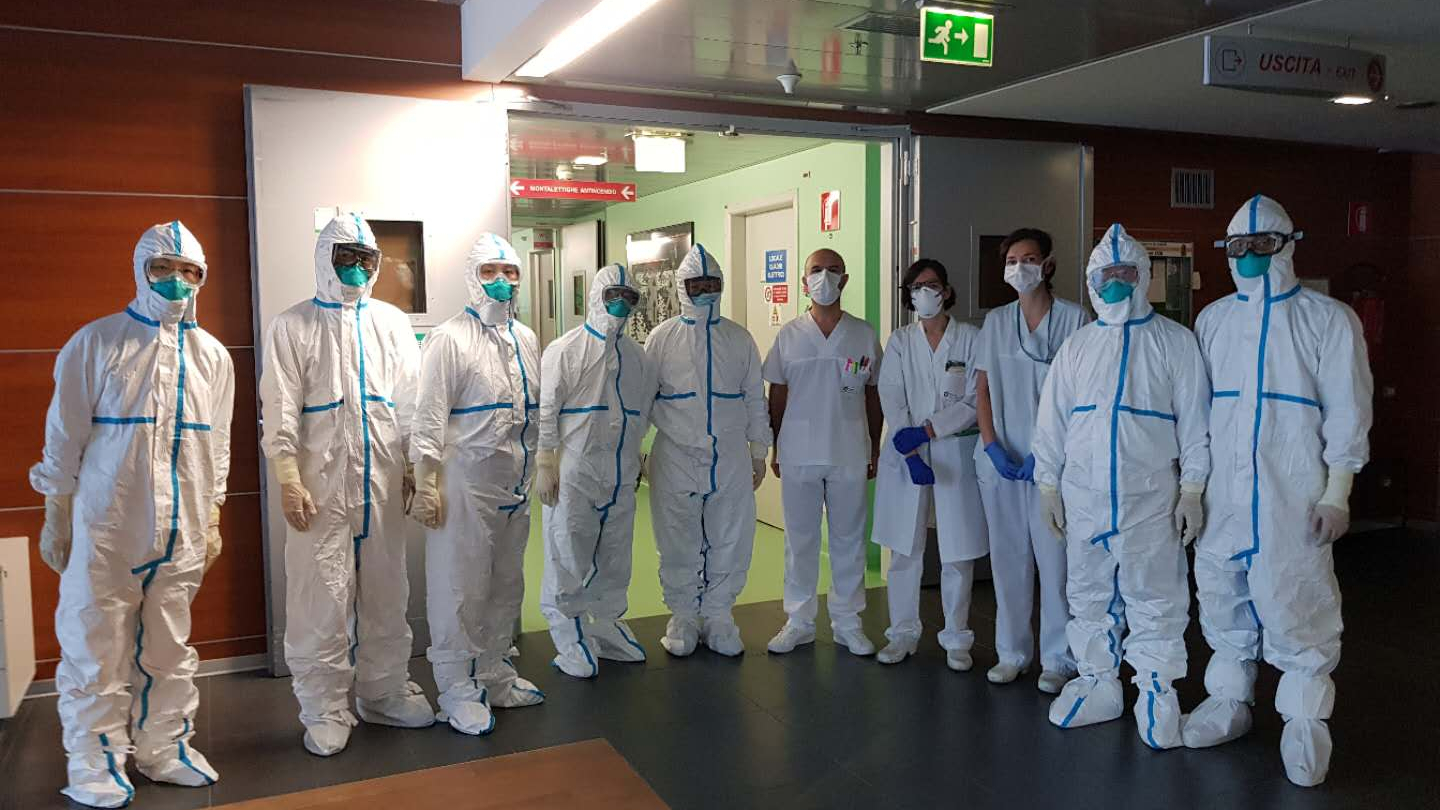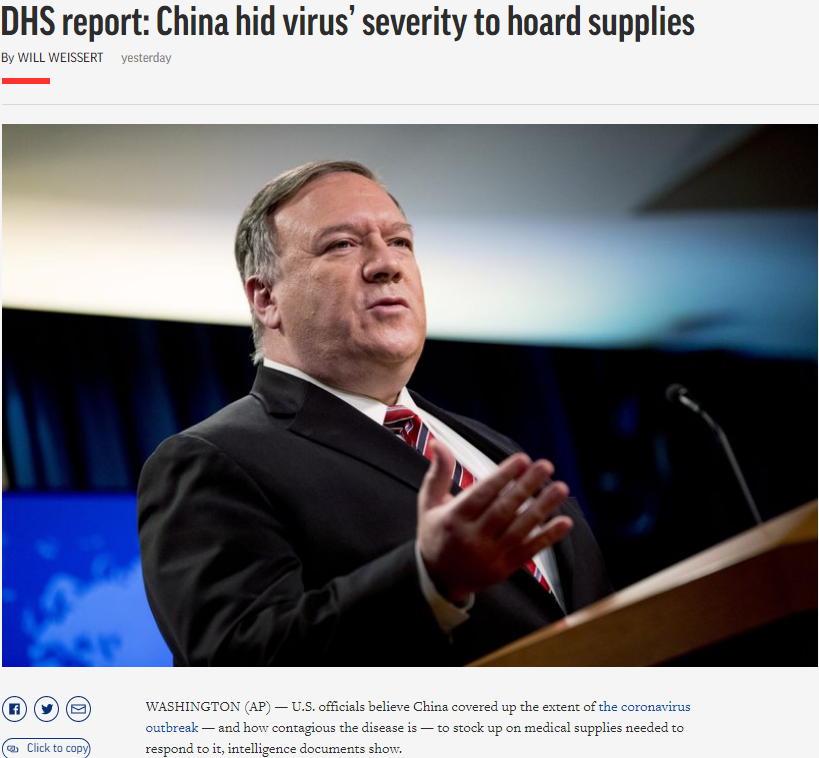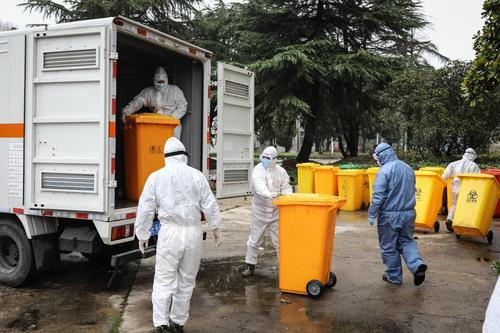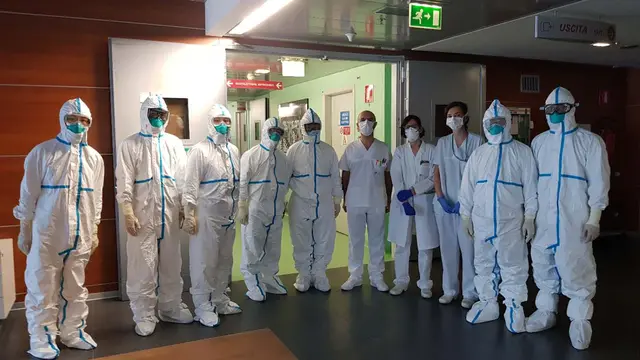
The second batch of Chinese COVID-19 experts in Italy. /courtesy of the team
As of May 11, there were 1.36 million confirmed COVID-19 cases in the U.S., with fatalities past 80, 000. The virus has swept across the world's most powerful country almost unhindered, cutting devastating swaths through cities and states. Even the White House, the heart of the country, has not been spared. How far would the pandemic go? No one can tell.
However, even in such a dire situation, the administrative authorities in the U.S., instead of focusing on saving its people from struggling in the throes of the pandemic, have gone full throttle on collecting "evidence" to scapegoat China. The U.S. Department of Homeland Security (DHS) recently released a report, accusing China of deliberately concealing the severity of the outbreak in Wuhan to the world in January and "stockpiling medical supplies by both increasing imports and decreasing exports."
Its conclusion is drawn on the basis of imports and exports statistics of February, which show significant declines in China's global exports of medical products. For example, exports of surgical gowns fell by 71 percent, surgical masks by 48 percent, medical ventilators by 45 percent, and intubation kits by 56 percent. The report also alleges the Chinese government tried to cover up such efforts by denying the existence of export restrictions as well as merging trade figures and delaying the release of them.
As a matter of fact, such "evidence" is not only inherently flawed, but also logically absurd.

A screenshot of the AP News report of DHS's document.
First, there has never been concealment about the outbreak in Wuhan. China reported cases of pneumonia of unknown cause to the World Health Organization (WHO) and informed other countries of the situation as early as January 3. Since then, it has been sending regular and timely updates about COVID-19 to WHO and countries around the world including the U.S., and to China's Hong Kong, Macao and Taiwan regions.
From January 3 to February 3, China notified the U.S. 30 times of the epidemic and control measures. On January 4, through a video conference, director of the Chinese Center for Disease Control and Prevention spoke to his U.S. counterpart, informing him of the newly emerging disease and exchanging views on relevant research, as well as its prevention and control.
On January 12, China shared the genome sequence with WHO and uploaded it to the Global Initiative on Sharing All Influenza Data (GISAID). On January 23, China decisively and resolutely locked down the city of Wuhan, sending a strong warning signal to the rest of the world. Two days later, on January 25, the U.S. became the first country to evacuate staff at the American Consulate General in the city and later, on February 2, closed its borders to all Chinese citizens and foreign nationals with a travel history to China within the past 14 days. From this clear and well-documented timeline, how could one draw the conclusion that China was covering up the situation in Wuhan?
Second, the allegation that China restricted exports while ramping up imports of medical goods is groundless. January and February saw the height of the epidemic in China. Almost all countries hit by the sudden and overwhelming outbreak were inadequately prepared in terms of medical staff, hospital beds and medical resources. China was no exception. More than 330 medical teams consisting of 42,000 medical workers were urgently sent to Hubei Province, especially the city Wuhan, from all over the country to support the fight against the virus. And a number of specialized and makeshift hospitals were swiftly built to accept as many confirmed and suspected cases as possible.

Volunteers transfer trash cans full of medical waste at a waste storage point in Wuhan, central China's Hubei Province. /China Youth Daily
Hospitals and medical staff were in desperate need of substantial quantities of medical facilities and protection gear. With companies and transport shut down by the spread of the virus, the Chinese government strained every sinew to ensure the supply of medical resources and daily necessities, saving lives and safeguarding public health. Even so, from January 24 to February 29 when Wuhan was in a complete lockdown, China still exported 2.46 billion pieces of anti-epidemic supplies totaling 8.21 billion yuan, including 2.4 billion protective gears, 2.02 billion facial masks and 25.38 million medical gowns, according to data from the General Administration of Customs.
As the virus spread to other parts of the world, the Chinese government urged relevant companies to resume production and provides assistance to help them overcome difficulties so as to meet the global demand for crucial medical goods. Just as is put by the Canadian newspaper
The Globe and Mail,
China is making history by manufacturing the goods the world needs at record speed and helping people worldwide to cope with the COVID-19 crisis.
According to data from the General Administration of Customs, from March 1 to April 30, China exported 27.8 billion masks, 130 million protective gowns, 12.57 million infrared thermometers, 49,000 ventilators, 73.41 million nucleic acid testing kits, 43.63 million goggles and 850 million surgical gloves.
On the exports of anti-epidemic supplies, China's Foreign Ministry spokesperson Geng Shuang, at his regular press conference on March 9, made it clear that China is willing to overcome domestic challenges and provide protective equipment such as masks to countries in need. On April 5, China's Ministry of Commerce spokesperson reiterated that China would not put restrictions on the exports of medical supplies.

Workers unloading Chinese-donated medical supplies at the Nursultan Nazarbayev International Airport, Nur-Sultan, Kazakhstan, April 9, 2020. /Xinhua
Despite the relentless effort of American politicians to vilify China, protective equipment has been continuously shipped to the U.S. to meet its need of treating patients. According to data from the General Administration of Customs, by May 5, China provided the U.S. with over 6.6 billion masks, 340 million surgical gloves, 44.09 million protective gowns, 6.75 million goggles and nearly 7,500 ventilators.
At the beginning of the outbreak, medical resources and aid relief materials were sent to China from many countries including Japan, Pakistan, and Russia, carrying heartwarming messages such as "Lands apart, sky shared." China has a tradition of reciprocating kindness. When the world public health and safety were facing unprecedented challenges from the spread of the COVID-19 virus in March, China started to offer help to other countries to the best of its ability as the situation in China was brought sufficiently under control.
So far, China has already provided medical supplies to over 150 countries and international organizations, and sent medical teams to 16 countries to fight the virus. China has unreservedly shared its experiences in disease control and treatment with the international community in the hope that the world would be able to defeat the virus at an early date. As part of such effort, China's CGTN launched "COVID-19 Frontline," a special program dedicated to providing a platform for online face-to-face communication between Chinese doctors and their foreign counterparts. With over 50 video conferences held and broadcast so far, the program has registered 190 million views, including 160 million from overseas.
It is due to these reasons that the accusations against China made by the DHS report are factually incorrect, logically absurd and completely groundless.
"When they go low, we go high," former First Lady Michelle Obama once said. But, the American politicians will continue to go all out fabricating "facts," distorting reality and blaming China for its own failure in fighting the pandemic. However, lies won't make the virus disappear and liars will be judged poorly by history. As time passes, China's courageous fight against the virus will be understood and lauded across the world.
(If you want to contribute and have specific expertise, please contact us at [email protected].)
 简体中文
简体中文

